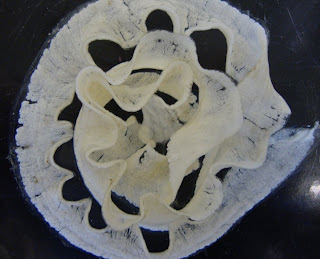
The morning of the 4th of May, our Embryology class met an hour earlier than usual and descended into the mudflats behind the “Fisherman’s Grotto” restaurant in Charleston, OR. We are studying the development of
spiralians, a large supra-phyletic group of protostome animals that undergo
spiral cleavage. Today our goal was to collect worms of two spiralian phyla (nemerteans and annelids), and a representative of a third (non-spiralian) phylum - the Phoronida, to culture in class.

First, we collected the polychaete annelid,
Owenia collaris.
Owenia lives in a soft, flexible sandy tube and has a very interesting larva, called the
mitraria, unique among the polychaetes. We also collected two species of nemerteans which have the
pilidium larva:
Cerebratulus cf.
marginatus (the large brown worm in the palm of a student in the third picture), and
Micrura alaskensis.
Cerebratulus is very fragile, and easily breaks into many pieces, so we had to be very careful when extracting the worm from the mud.
M. alaskensis is a small, pink nemertean that looks like a tiny thread in the mud. Though small,
M. alaskensis is common, ranges from Alaska to northern California, and is easily raised to metamorphosis on a diet of unicellular algae.

Last but not least, we collected the phoronid worms,
Phoronopsis harmeri (formerly known as
Phoronopsis viridis).
P. harmeri lives in a thick rigid sandy tube 15-20 cm long. Phoronids are commonly known as “horseshoe worms” because of the characteristic crown of feeding tentacles, called the
lophophore, arranged in a horseshoe pattern around the mouth of the adult worm.
P. harmeri, like most phoronids, has a unique planktotrophic larva, the
actinotroch, which is characterized by a pre-oral hood, and a crown of tentacles used for feeding.
 This is the brachiolaria larva of a starfish, Pisaster ochraceous,that I raised during the Embryology class. Larval anterior end is up, and you are looking at the ventral side. The brachiolaria is characterized by the presence of brachiolar arms and an adhesive disk, and the bottom image shows a close up of the pre-oral protuberance of the frontal lobe that bears these structures. The brachiolaria larva follows the bipinnaria larval stage in the forcipulates, a group of starfish.
This is the brachiolaria larva of a starfish, Pisaster ochraceous,that I raised during the Embryology class. Larval anterior end is up, and you are looking at the ventral side. The brachiolaria is characterized by the presence of brachiolar arms and an adhesive disk, and the bottom image shows a close up of the pre-oral protuberance of the frontal lobe that bears these structures. The brachiolaria larva follows the bipinnaria larval stage in the forcipulates, a group of starfish.  The brachiolaria is the last larval stage in these asteroids. It is characterized by three brachiolar arms (the three stubby arm buds near the top of the larva in the first image and zoomed in on in the second image) which surround a central adhesive disk (the brown spot between the lower two brachiolar arms in both images). These appendages have sticky cells and are used to make contact with the substratum when the larva is competent to settle. Some other asteroids, that have lecithotrophic, or non-feeding development, skip the bipinnaria stage, and directly produce large yolky brachiolaria with three brachiolar arms and an adhesive disk also used for settlement and attachment.
The brachiolaria is the last larval stage in these asteroids. It is characterized by three brachiolar arms (the three stubby arm buds near the top of the larva in the first image and zoomed in on in the second image) which surround a central adhesive disk (the brown spot between the lower two brachiolar arms in both images). These appendages have sticky cells and are used to make contact with the substratum when the larva is competent to settle. Some other asteroids, that have lecithotrophic, or non-feeding development, skip the bipinnaria stage, and directly produce large yolky brachiolaria with three brachiolar arms and an adhesive disk also used for settlement and attachment.


















































